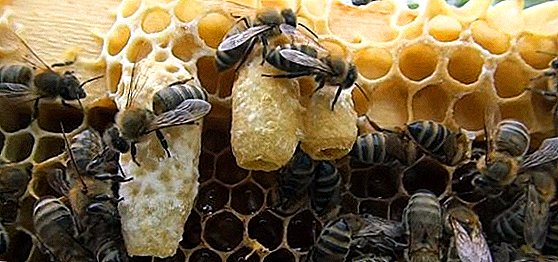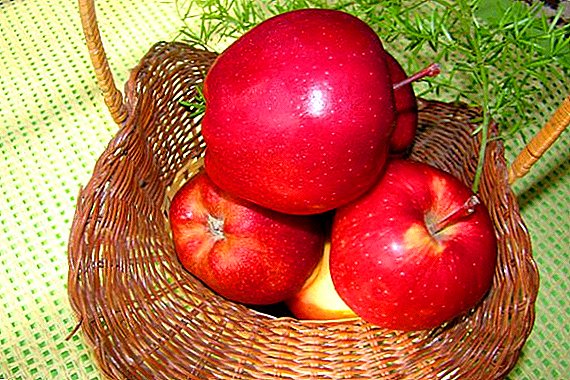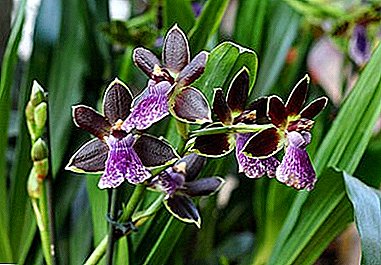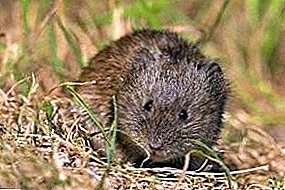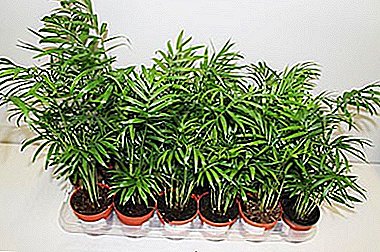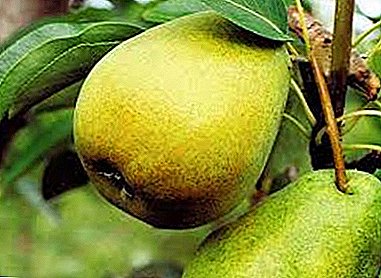
Grapes are a very special culture, which is consumed not only fresh, but also widely used in the preparation of desserts, salads, compotes, juices and, of course, all sorts of wines.
There are many varieties of this culture. They differ in taste, color of berries and scope of application.
To taste, the grapes are divided into ordinary, solanaceous, nutmeg and isabel.
The grape berry is very rich in organic acids, B vitamins and minerals. This culture is a great therapeutic value. It helps to treat kidney disease, heart disease, and even asthma.
Berry is very widely used in cosmetology. And grape juice is used in the treatment of migraine, to improve immunity and prevent chronic fatigue.
To grape vine decorated garden or courtyard of the house, it is necessary to master some of the secrets of its cultivation. The planting process is important for many crops, and this also applies to grapes.
Features of the choice of cuttings

In order for the grape crop to enjoy the harvest of berries and the beautiful shade of a green vine for many years, it is necessary to determine the type of crop that you like best to your taste and which is best suited for growing in your area.
Bred grapes from seeds and vegetatively. From seed, new grape plants are grown only by breeders during the breeding of new varieties, and vegetative propagation is suitable for us.
There are several vegetation methods grape culture:
- planting cuttings
- branch of a rod
- grafting method
During vegetative propagation, the whole biological complex of the mother bush is preserved in the plant. This method is based on the excellent regeneration features of this culture.
This feature is characteristic of all parts of the vine: the roots, and the stems, and the petioles of the leaves, and the legs of the inflorescences and berries. Thanks to this, the grapes perfectly restored, heals wounds and leaves after being damaged by winter frost.
But to grow a new bush is possible only from a segment of a vine of grapes on which there is a bud. For this shoots are bruised, after which such a cut (stalk) becomes planted, ready for landing.
There are several reliable cutting methods for grape growing. And if you take advantage of some of them, then the planted stalk will become a good bush by the end of next summer.
The main thing is that when harvesting the stalk, it is necessary to carefully select the vine, which should be perfectly ripe, about 1-1.2 m in length, and 6-10 mm in diameter. Visually, the ratio of the total circumference of the trunk to its core, suitable for a vine cutting, should be at least two. Still, she should crackle when bent. This is due to the rupture of cork fibers.
Choosing vines for cutting cuttings, you should not forget that this affects the survival of the process, and getting a good bush as a result. In addition, cut off the vine should be properly prepared for planting.
Preparing the cutting for planting

On the landing of any culture take only healthy fathoms. This rule applies to grapes.
The cut of a root in a healthy cutting will always be white, and in the one-year appendix it will be bright green. Eyes cuttings should not pour when pressed. Drying fresh soot is not permissible.
If the grape stalk is not prepared correctly, it can die. Shoots die in the event of insufficient air intake and their rotting as a result, as well as in the case of lack of moisture and their drying.
The vine is cut into cuttings so that their thickness is not less than the thickness of the little finger - this is about 7 mm, and the length corresponds to 30-40 cm. There must be three or four buds on the handle. The cutting should not be cut very long, as this will complicate the subsequent work with it. Cut stalks do not hold for a long time in the air and in a warm place.
Grape cuttings cut very sharp knife or a razor. The cuts are made so that the lower part of the slice is near the eye, located at the bottom, and the upper part is located 2-3 cm above the top. After that, the prepared appendix is put for a couple of days to soak in clean water at room temperature.
Then a cutting slice, located at the top, is dipped into the melted paraffin for a few seconds, and the lower end of the cutting is placed in a solution with a growth stimulator for another 24 hours. After carrying out all these procedures, the cutting can be planted in a prepared pit.
Cuttings in autumn can be left as well until spring. For this purpose, they are tied up in bunches and so are stored in the basement, or they are dropped in a trench, while covering with straw. So billets overwinter until spring.
What soil is suitable for planting

Grape bushes can grow on absolutely any soil. But, if you are interested in a good harvest, as well as in a certain quality of juice and wort of this plant, then you should carefully check the soil and properly prepare it for planting.
Need to know that different varieties of this culture love different soil. For example, if it is a table variety, it is necessary to select a place at the foot of the hill, where the alluvial soil is rich in humus, and the groundwater is located at a depth of 3 m.
Grapes grow best on stony and dark soils, which strongly absorb the radiation of sunlight. It is known that in the grapevine the water is in bound and free form, and during different vegetative phases, this ratio changes.
In the soil that is swamped, the roots of the plant do not grow, and sometimes even die due to the lack of oxygen in such soil. Therefore, the place where the shrub grows in this culture must often be loosened and mulched.
In hot summer, the land is stopped to loosen, but it is mandatory to mulch.
Negatively affect the grape plant and stationary, near the underlying water of the soil (depth of not less than 1.5 m). In this case, the soil, to ensure free access of air to the roots of the plant, is also loosened. Good for the cultivation of grapes are clayey loose soils, low-carbonate or carbonate, as well as stony soils.
Very rapid ripening of berries shows grapes growing on light colored sandy soil. And the growth of shoots is observed stronger in the bushes that grow on black soil or red soil.
The best for grape culture consider light groundwhich tends to warm up well. This may be sandy soil, sierozem, light and dark chestnut soil.
If, however, in the garden, the soil is still heavy, then preparing it for planting grapes, sand, gravel, silt, broken brick, or other drainage and manure, which has already perepel. The saline soils of the site are prepared for planting a crop of grapes by abundant irrigation of land in summer and autumn, followed by drainage.

It is not advisable to plant new bushes at the place of breeding of the old vineyard. Planting young grapes in such a place can be only after two or three years after uprooting the old one.
Do not plant grapes in places with poor airing, between the rows of trees, and in those places that are constantly darkened. The vine does not tolerate all sorts of depressions in which the cold stagnates.
Best suited for the cultivation of grapes sunny southern slopes with an excellent flow of air, but at the same time closed from the cold winds. It is necessary to place the grapes in such a way that other plants do not interfere with its growth, and also do not plant this crop near the plantations requiring frequent watering.
Land preparation for grapes is made with the best effect in autumn. This event is no less important than the choice of the place for landing. The most effective method for the preparation of land for grapes is plantazh. This is a method during which the land on the site is completely transshipped, while the soil is processed and fertilized.
Grape saplings put in a south-north direction. For the landing, special trenches are prepared, ahead of time marked with a width of 80-100 cm. When digging trenches, the land is alternately scattered one way or the other.
Mineral fertilizers and humus mixed with the soil are laid at the bottom of the depression. Even in the pit add large crushed stone, which is also mixed with the already fed soil. Then the trench is alternately filled with soil and humus with rubble, while no crushed stone is added to the top layer of powder.
Go to landing

Planting grape cuttings is a very painstaking and difficult work, which greatly influences the subsequent growth and development of a young plant. In addition to the soil for planting and the place where it will grow, it is important to determine the time of planting grapes, as well as remember some secrets and features of the planting itself.
Grapes planted in the fall and spring. Annual seedlings, which are stiff, sown in the middle of spring (April - May), vegetative green cuttings are planted in late spring and early summer (May - June). In autumn, the grapes are planted from October until the first freezing of the soil.
When planting grapes in the fall, they must be properly prepared for wintering. For this they:
- Cover with a cut plastic bottle
- watered around with water (3-4 buckets)
- after that loosened around the soil
Before the arrival of frost, the grapes are covered with pine needles, sawdust or peat, and the entire landing hole is filled up with it. Protecting the young plant and use the usual land, which is filled with planting hole, and then made from the soil 30 cm tall mound.
A stalk planted in the fall has the ability and time to develop the root system. This will allow the next year the sapling to turn into a good bush.
Landing tips
Grapes very does not like frost and cold. The roots of this plant can freeze already at a temperature of -5 - 7 degrees. Therefore, where there is a deep freezing of the soil, it is recommended to carry out an in-depth planting of seedlings, or to make inoculation of growing varieties on the Arctic or Buytur.
In addition, in such areas it is advised to plant on the spot where a lot of snow accumulates in winter or snow retention measures are taken.
Experienced gardeners are advised to plant cuttings, deepening the lower part of the seedling by 30-35 cm or 40-50 cm to the ground, depending on the warming up of the soil in the spring and its moistening, and, in the case of planting the cutting, in an area where there is no snow in the winter, and the temperature is low. This will prevent freezing rhizome of grapes.
To create favorable conditions for rooting, immediately before the cutting is dipped into the landing hole, poured about one bucket of hot water. Planting plants take roots that have reached three centimeters.
Landing pattern

There are several planting schemes cuttings:
- landing with a tilt
- landing vertically
Fans mostly use the landing with a slope.
Planting a grape stalk according to a pattern with a slope, the roots on the handle are not cut, but care must be taken to ensure that the length of such roots is no more than 10 cm. If you use a vertical planting pattern, the roots above the second node are cut.
Planting many cuttings in the same row, the distance between them is no less than 2-2.3 m, and between rows - 2.5-3 m. Frost-resistant and covering varieties should be planted separately.
For vertical and two-plane inclined trellis bush rows and their backwaters are located in the north-south direction. If the planting of grapes used trellis with a visor, vertical, the rows and supports are located in the direction of east-west.
With this planting, all sheets of grapes fall under direct sunlight, and this is important for productivity and photosynthesis.
You can also plant cuttings singly - on separate supports, or in rows - on one common support. Indentation between the bushes is done depending on the characteristics of a particular variety or variety, and it corresponds to 1.5-2.5 m.
The grape pit is prepared using three methods:
- under the scrap,
- digging pits in size 60 × 80 cm,
- plantation plowing 60-70 cm deep
The depth of the pit, on chernozem, for cuttings, is made at 60 cm, on poor soil, 1 m. At the same time, the cutting is planted so that the upper peephole after planting is 5-6 cm below the edge of the hole edge. growth trunk bush above the ground. The landing pattern is clearly visible in the figure below.

It should be remembered that the rhizome of grapes develops very quickly and grows rapidly. Therefore, planting shoots of this culture close to one another is undesirable.
It is also interesting to read about pruning grapes in the fall.
Departure after landing
After disembarking, the ground poured into the hole should be compacted by tamping, and the resulting furrows should be poured abundantly with water, and filled to the ground with the ground. If the cuttings are not previously paraffined and the weather in the zone is sufficiently dry, a permanent hilling of the sprouts is done before the first shoots, and the shkuku is watered abundantly, periodically loosening the soil.
Still required to monitor the emergence of weeds, which are necessarily removed. If necessary also make spraying with a weak 1% solution of Bordeaux liquor.

Any soil tends to tire. This happens with the land of the vineyard, if you do not carry out preventive measures for feeding and fertilizing the soil. For this purpose, they make a change of crops on the site, as well as produce soil rest and sowing grass mixtures.
From soil fatigue will save fertilizer organic soil and rejuvenation of the rhizome of a culture with a fair watering. In this case, it is mandatory to mulch, and 1-2 loosening under the bushes for the season. This is done without turning the layers of the earth and shifting organic mulch.
The first time after planting (2-3 years) is the most important for good growth and normal development of grapes. At this time, the shape of a young bush. After growing to 5-8 cm in length, culture shoots break off, leaving 1-2 shoots on the handle.
They also conduct regular katarovka, which involves the removal of surface roots. From autumn to winter, bushes are covered with improvised material.


